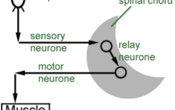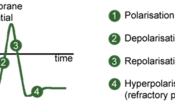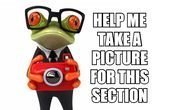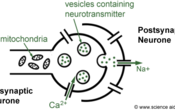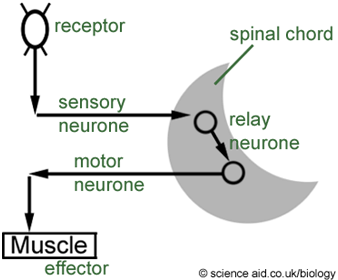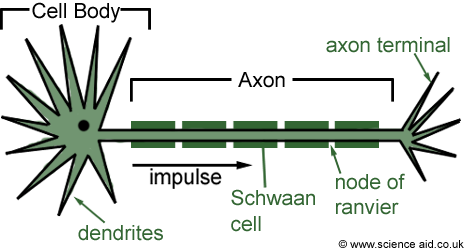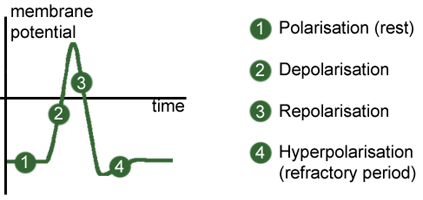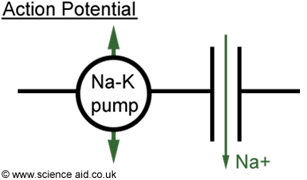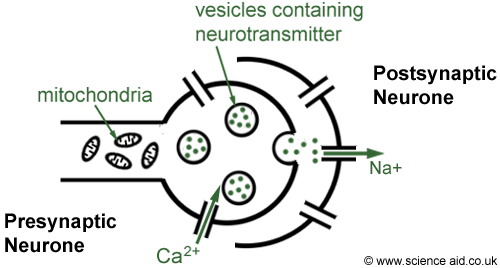Nervous System
Edited by Jamie (ScienceAid Editor), Taylor (ScienceAid Editor)
Reflex Arc
Above is a reflex arc, it is a simple example of nervous coordination.
- 1It begins with a stimulus at the receptor.Stimulus.Advertisement
- 2This causes an impulse. In the spinal chord (part of the central nervous system).Impulse.
- 3Relay neurones send the impulse to an effector.Effector.
Reflexes are useful because they are quick and can help us adapt very quickly to the environment without the need for conscious control. For example, the knee jerk reaction where the leg jumps forwards if the patellar tendon (just below the knee) is stimulated.
The diagram below shows the structure of a myelinated (covered in fatty insulator) motor neurone. Pay particular attention to the cells. These are wrapped around the axon and provide the insulation, there are gaps between these called the nodes of Ranvier.
Action Potentials
The graph below shows the stages of an impulse in the nerves. Note how the potential goes from negative to positive.
- 1Firstly we will look at what the nerve does when it is not being stimulated, and is in a state called resting potential. In this state the membrane is polarized where the inside is negative and outside is positive. This is maintained by sodium-potassium pumps which move 3Na+ ions out for every 2K+ in. Protein channels for K+ are open so that some potassium will diffuse out, but sodium (Na) channels are closed. So overall there are more positive ions outside and therefore a potential difference is created.Resting Potential.
- 2When a neurone is stimulated an action potential is generated. The neurone is depolarized, this is done by sodium channels opening (the membrane is more permeable to Na+), and since there is a high concentration of sodium ions from the pumps, lots move in and push up the charge to about +40mv. The pump's actions stays the same.Depolarized.
- 3Once the charge has reached a certain level, the Na+ channels close and K+ open allowing potassium out. Meanwhile the pumps continue to remove sodium so the overall charge in the neurone falls. This stage is re-polarization since we are returning to the polarized state.Repolarization.
- 4Notice on the graph how the charge falls below the resting level? This is called hyperpolarization, and the time it occupies is the refractory period. It results from the time delay in closing channels. This is useful because it prevents any impulse being directly after this one.Hyperpolarization.
Saltatory Conduction
In an unmyelinated neurone, this process will happen along the entire length: which is relatively slow. However, in a myelinated neurone (see above) it only happens at the nodes of Ranvier, therefore the charge jumps from node to node when each charge is generated. This is known as saltatory conduction and means that the impulse is several times faster.
Synapses
A synapse is a junction between two neurones. There is a gap called the cleft that the signal must cross. The presynaptic neurone is where the impulse comes from, and it travels to the postsynaptic neurone. When the impulse arrives at the presynaptic neurone, calcium ion channels open, and the membrane becomes more permeable to calcium. This enters the cell and causes the vesicles to release the neurotransmitter (acetylcholine) by exocytosis in to the cleft.
On the postsynaptic membrane are neuroreceptors, where the acetylcholine binds and and is broken down by acetylcholinesterase [ah-seat-iyl-ko-lyn-es-ter-ayse] into ethanoic acid and choline. These reenter the presynaptic neurone and are resynthesized by ATP.
The neurotransmitter binding causes the depolarization of the postsynaptic neurone, which initiates an actional potential there.
Referencing this Article
If you need to reference this article in your work, you can copy-paste the following depending on your required format:
APA (American Psychological Association)
Nervous System. (2017). In ScienceAid. Retrieved Apr 19, 2024, from https://scienceaid.net/biology/humans/nerves.html
MLA (Modern Language Association) "Nervous System." ScienceAid, scienceaid.net/biology/humans/nerves.html Accessed 19 Apr 2024.
Chicago / Turabian ScienceAid.net. "Nervous System." Accessed Apr 19, 2024. https://scienceaid.net/biology/humans/nerves.html.
If you have problems with any of the steps in this article, please ask a question for more help, or post in the comments section below.
Comments
Article Info
Categories : Humans
Recent edits by: Jamie (ScienceAid Editor)
